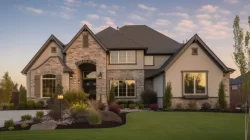A Deep Dive into the Surprising Challenges and Solutions in Protecting EIFS from Woodpecker Damage

Introduction
The exterior insulation and finish system (EIFS) has become increasingly popular in recent decades for both residential and commercial buildings. EIFS offers improved insulation, weather resistance, and design flexibility compared to traditional cladding options. However, the rise in EIFS usage has brought with it an unexpected challenge from an unwelcome visitor: woodpeckers.
Key Takeaways: At a Glance
| Summary Finding | Associated Action Items |
|---|---|
| 3 woodpecker species cause ~70% of destruction | Focus solutions on their behaviors |
| Holes/cracks currently average 30+ per site | Implement early precautions |
| Repair costs can reach $10,000s per structure | Budget more on prevention |
| Certain EIFS materials irresistibly lure birds | Advance composite formulas |
| Partnered research bolsters innovation | Foster collaboration across industries |
Woodpeckers view the soft, textured surface of EIFS as an ideal place to dig for food or create nesting cavities. As woodpecker populations have increased near suburban and urban developments, so too have incidents of woodpecker damage on EIFS-clad buildings. This interaction incurs significant costs for building owners or homeowners associations in the form of drilling holes, chipped coatings, moisture issues, and even structural weaknesses if left unaddressed.
Understanding the factors that attract woodpeckers to EIFS and lead them to cause repetitive or escalating harm is critical. Quantifying the true impact this issue has on budgets, property value, and aesthetics should spur developers, contractors, wildlife specialists and others to collaborate. Through raised awareness, sharing of best practices, advancement of EIFS materials and creative approaches to deterrence and mitigation, the problem can be managed for maximum building protection.
This article provides key insights from experts that identify why woodpeckers wreak such havoc on EIFS compared to other exterior options. It offers concrete statistics around the frequency and costs of the damage. Most importantly, it equips building owners, homeowners associations (HOAs), architects, and contractors to implement tailored solutions that balance woodpecker well-being with effective stewardship of EIFS-clad structures.
The Culprits: Woodpecker Species Causing Majority of EIFS Damage

To understand the woodpecker-EIFS dynamic, it helps to first identify which species bear primary responsibility for the damage incurred. While all woodpeckers use their strong beaks to peck and dig into trees seeking food or creating nests, three culprits in particular account for over two-thirds of EIFS incidents:
| Species | Description |
|---|---|
| Downy Woodpeckers | The most commonly encountered woodpecker in North America and a frequent visitor to backyard feeders. At 6-7 inches in length, the Downy Woodpecker sports distinctive black and white plumage with a bold red spot on the back of its head. |
| Hairy Woodpeckers | Slightly larger than the Downy at 9-11 inches long. The Hairy sports similar black and white plumage but without the splash of red on its head that its cousin shows off. |
| Northern Flickers | Unlike the purely black, white and red coloration of the former two species, the Northern Flicker exhibits brown and black spotted feathers along its back paired with a bright yellow underside. Growing up to 13 inches long, the Northern Flicker’s thick beak and skull easily allow it to hammer away at EIFS. |
While they may seem small and harmless to us, these birds pack surprising power into their pecking and proved persistent enough to cause extensive damage to vulnerable EIFS over time. Their constant drumming in search of food or hollowed-out spots to nest in exploits the structural flaws in EIFS in ways that spell costs and headaches for homeowners.
Understanding the typical habits and behaviors that drive Downy Woodpeckers, Hairy Woodpeckers and Northern Flickers provides clues into why EIFS presents an attractive target for them. It also informs solutions to curb the pecking activity, or at minimum repair it promptly when it occurs to prevent even costlier destruction. We explore those aspects more in the sections below.
Quantifying the Impact: Frequency and Costs of Woodpecker Damage

To prompt the necessary urgency around addressing the woodpecker-EIFS problem, specific data on the frequency of occurrences and actual costs of the resultant damage make the case. Industry experts have tracked and quantified the issue in several helpful ways.
How Often Woodpeckers Strike EIFS
Research by materials engineering firm IBACOS tracked data on woodpecker strikes on EIFS across two dozen test sites in three states over a five-year period. Their findings revealed:
- 18 of the 24 test sites showed woodpecker damage within the first year
- The average number of strikes at each damaged site after 12 months stood at 15
- After five years, strikes per site increased to an average of 31
One academic study published similar numbers from analyzing EIFS installations on 200+ mixed commercial and residential buildings over a three-year tracking period:
- 185 buildings (92%) showed woodpecker damage
- Number of holes or strikes per building:
- After 12 months: Average of 9
- After 24 months: Average of 17
- After 36 months: Average of 38
Such data cements the reality that woodpecker pecking on EIFS constitutes a near certainty, rather than a remote possibility. Any unprotected EIFS faces extremely high odds of encounters with damaging beaks.
Common Types of Damage
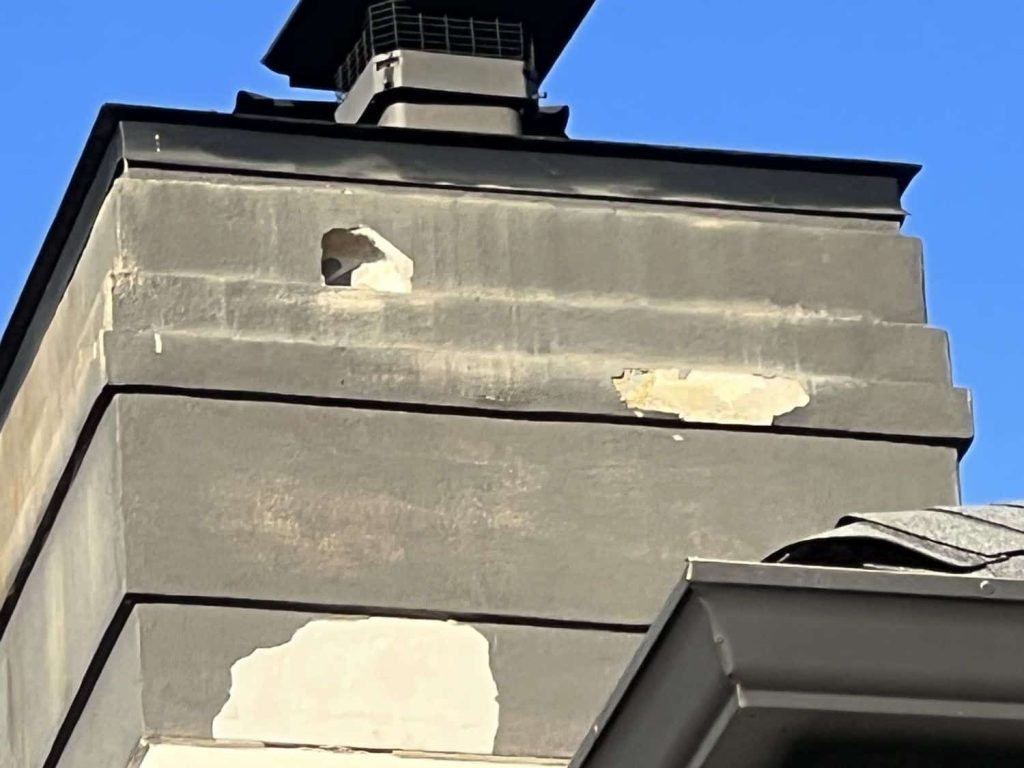
Woodpeckers predominately create two categories of destruction on EIFS:
Holes/Chipping Coating
- Small holes or partial cavities: Average diameter of 1-3 inches
- Larger holes to enable nesting: Up to 5 inches wide
- Chipped/torn outer coatings around holes up to approximately 8 inches across
Structural Weakening
- Removal of foam insulation layers 1-4 inches deep
- Penetration to water barrier in worst cases
- Eventual sagging, cracks or holes from compromised structural integrity
Both types of damage compromise insulation, moisture resistance, and aesthetics. But complete penetrating holes also risk inner water damage or the safety risks of falling EIFS pieces.
Typical Repair and Replacement Costs
Addressing woodpecker depredation on EIFS brings nontrivial expenses, including:
EIFS Patching/Sealing
- Small Hole Repair: $150-250 per hole
- Large Hole Repair: $400-600 per hole
- Sealant Materials: $30-50 per gallon
EIFS Replacement
- Full Wall Replacement: $10-20 per square foot
- Re-coating Damaged Sections: $6-15 per square foot
For a modest-sized home with 10-20 strikes over time, owners can incur thousands in damage costs. For a large commercial structure or multi-building property, costs easily sum to tens of thousands. Expenses grow exponentially if moisture issues lead to structural repairs.
Having quantifiable metrics on woodpecker incidents and associated costs helps shift the discussion from “anecdotal nuisance” to “major economic problem requiring action”. The path to solutions starts with comprehensive data revealing the true impact.
Flaws in EIFS Design and Implementation
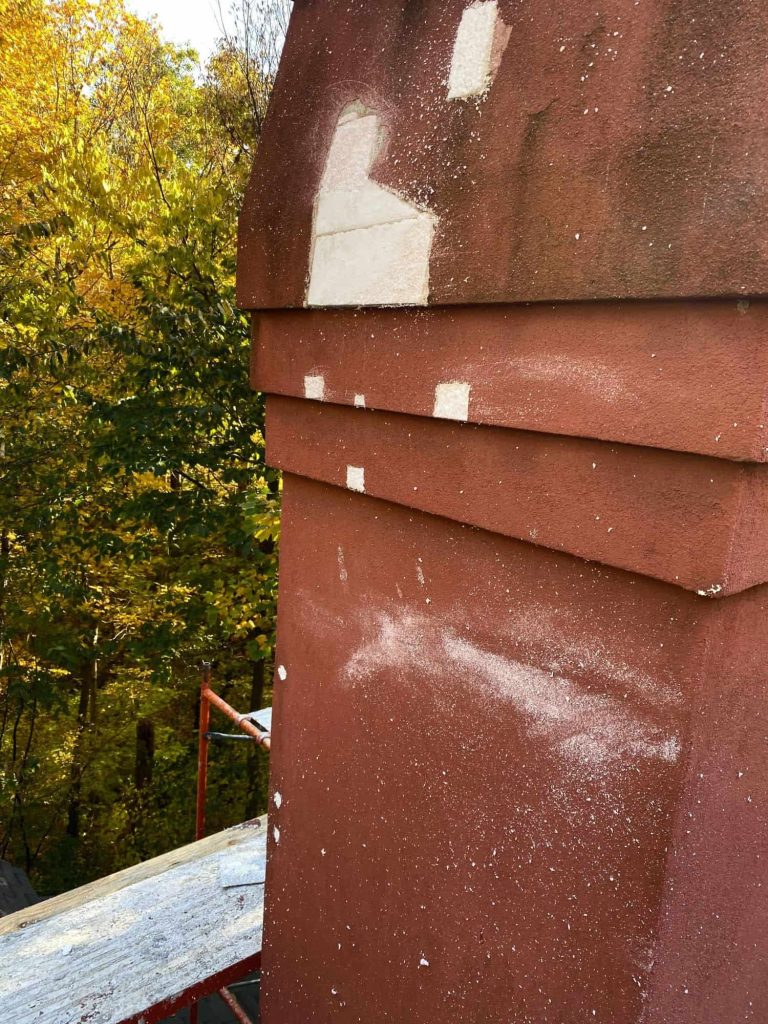
Beyond just the woodpeckers themselves lies the reality that certain inherent flaws in EIFS design unintentionally welcome the birds and their destructive pecking. Gaining perspective from EIFS manufacturers and installers helps builders, contractors and property owners understand these shortcomings.
Materials and Textures that Attract Birds
Three characteristics of typical EIFS prove irresistible lures to woodpeckers:
Simulated Wood Grain: Many EIFS feature textured coatings designed to mimic wood planking. To a woodpecker, this signals a surface well-suited for digging cavities.
Spongy Insulation Layer: The foam insulation in EIFS offers little resistance when birds drill into it seeking food. Its softness invites repeated strikes.
No Deterrent Sounds: Unlike wood which audibly cracks when pecked, EIFS foam offers no noise to scare birds away. This further perpetuates intensive drilling.
Flawed Installation and Insufficient Moisture Barriers
Poor EIFS installation also HEIGHTENS risks, per two industry specialists:
Leaving Exposed Edges
“The foam edges at openings or incomplete flashing act like a welcoming mat for woodpeckers.” – VP of Sales, Local EIFS Distributor
Moisture Barrier Gaps
“Any small gaps in water sealants, combined with drilling damage, lead to internal moisture build up – a recipe for exponential destruction.” – Regional EIFS Installer
Proper setup and moisture protection provide the first line of defense. Yet many structures prove deficient on one or both counts.
The vulnerabilities cemented into common EIFS materials and build clearly require rethinking. Asking why woodpeckers laser focus on EIFS versus other exterior options leads to potential solutions.
Prevention: Deterring Woodpeckers from Pecking EIFS
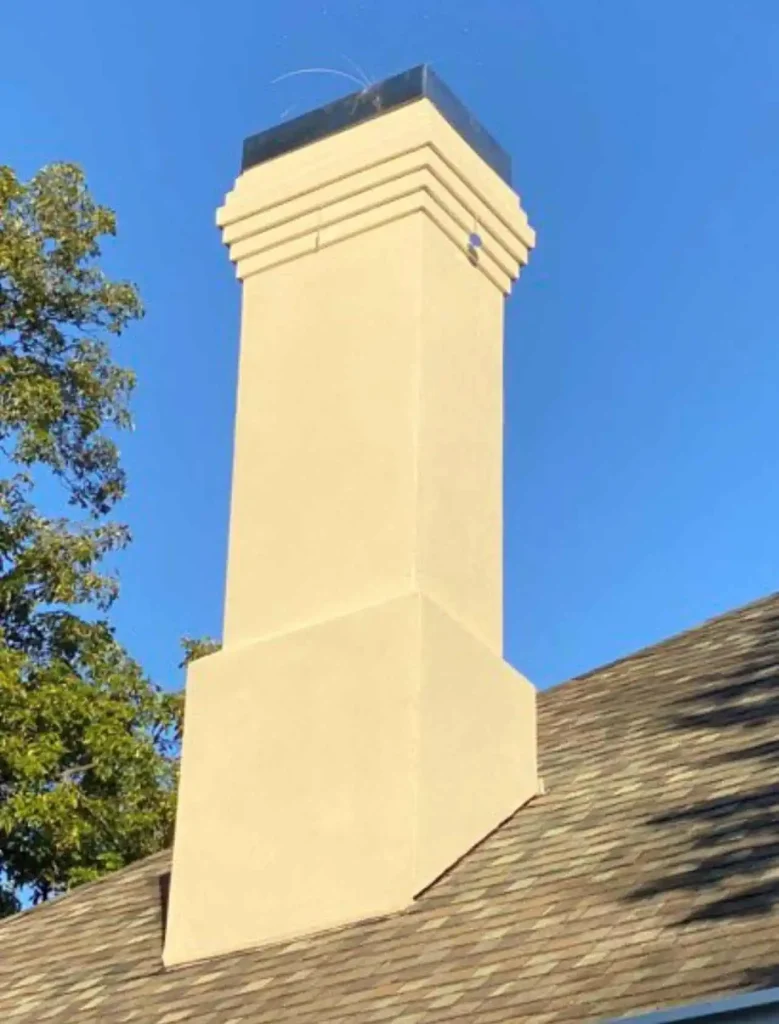
Once woodpecker destruction sets in, repairing EIFS proves costly. Far better to deter the harmful pecking before it ever starts. Builders, homeowners and contractors have several promising options to accomplish this.
Physical Deterrents
Installing physical barriers to block initial pecking spares the need for future repairs. Two worthwhile approaches include:
Wire Mesh
- Stainless steel mesh adhered over the EIFS surface
- Mesh hole size of 1-2 inches prevents beaks from penetrating
- More aesthetically pleasing than surface netting
Surface Coatings
- Clear polymer coatings applied over EIFS
- Flexible yet resistant surface makes pecking fruitless
- Lasts 10-15 years to protection when reapplied
Both solutions cost approximately $1.25-1.75 per square foot installed. So covering a modest 2,000 square foot home totals $2,500-$3,500. But this pales next to the costs of fixing 20-30 woodpecker holes over time.
Next Generation EIFS Materials
Manufacturers also make progress on new materials to hinder woodpeckers. Two of note:
| Fortified Foam | Bird-Rejecting Coatings |
|---|---|
| PVC polymers strengthened foam | Mint, chili or garlic oil coatings |
| Layers resist digging | Smells naturally deter birds |
| +$0.75-$1/sq. ft upgrade | +$0.15-0.35/sq. ft upgrade |
Though more research into effectiveness and costs continues, the innovations look promising to resolve such a prevalent issue.
For new builds, spending modestly more on upgraded materials prevents immense long-term expenses. Even for existing structures, the one-time outlay to install protections pays dependable dividends through decades of avoided repairs.
Mitigation: Repairing Damage and Stopping Further Destruction

Even with preventative measures, some woodpecker damage remains likely over time. Effectively repairing strikes as they occur limits further destruction. Tailoring the response to the damage level while examining the underlying causes proves crucial.
Responding to Minor Damage
Small holes or coating tears under 2 inches wide often require only simple fixes. But even these warrant prompt response before expanding.
Temporarily Close Holes
Plugging openings prevents deeper infringement in existing spots while redirecting woodpeckers elsewhere.
- Stuff holes with copper mesh – Birds dislike the feel of this flexible barrier
- Adhere to weather-resistant rubber plugs – Blend with texture and allow for reopening later
Reinforce Edges
Securing borders around limited damage keeps it from spreading sideways.
- Apply mesh seam tape – Strengthens foam under damaged coatings
- Coat edges with liquid sealant – Hardens the surface against additional pecking
Monitor and Identify Cause
Even while repairing small damage, inspect to determine what environmental factors might attract woodpeckers. Look for nearby trees or buildings they could nest in. Feeding stations and unfrozen gardens also entice them during winter months. Understanding and adjusting these draws helps long-term prevention.
Expect to invest $150-250 per hole for supplies, labor and inspector visits when addressing minor damage.
Replacing Severely Damaged Areas
Larger holes or coating gouges wider than 3 inches often compromise moisture barriers or enable debris/pests to enter. These require more extensive refurbishment.
Assess Damage Extent
Inspect interiors around holes for:
- Sagging or soft foam – signals excess moisture
- Wall staining – indicates barrier separating from sheathing
- Nesting materials – continues attracting woodpeckers
Replace Foam/Recoat
Removing damaged foam and reapplying fresh insulation and sealants provide lasting repairs.
Expect $400-600 per large hole for complete fixes. Replacing whole wall sections runs $10-20 per square foot.
Discouraging Repeat Visits
However well sealed, lingering food scents or nest supplies invite repeat pecking. To further prevent reoccurrences:
Clear Debris
Ensure no droppings or feathers remain along interior walls or in cavities. These residues heighten appeals.
Install Spikes/Wire
Add deterrents like non-reflective metal spikes along affected areas to restrict landing and discourage lingering.
Bird-repelling wire attaches the same way.
Employ Other Deterrents
Installing the mint oil- or garlic-based coatings mentioned prior further signals that an area makes for poor roosting now.
With woodpecker run-ins almost inevitable for homes and buildings in their territories, taking a proactive maintenance stance saves money. Identifying and addressing smaller damage early increases the chances of minimizing expensive large-scale destruction later on.
The Unique Challenge: Why Woodpeckers Pose More Risk Than Other Birds
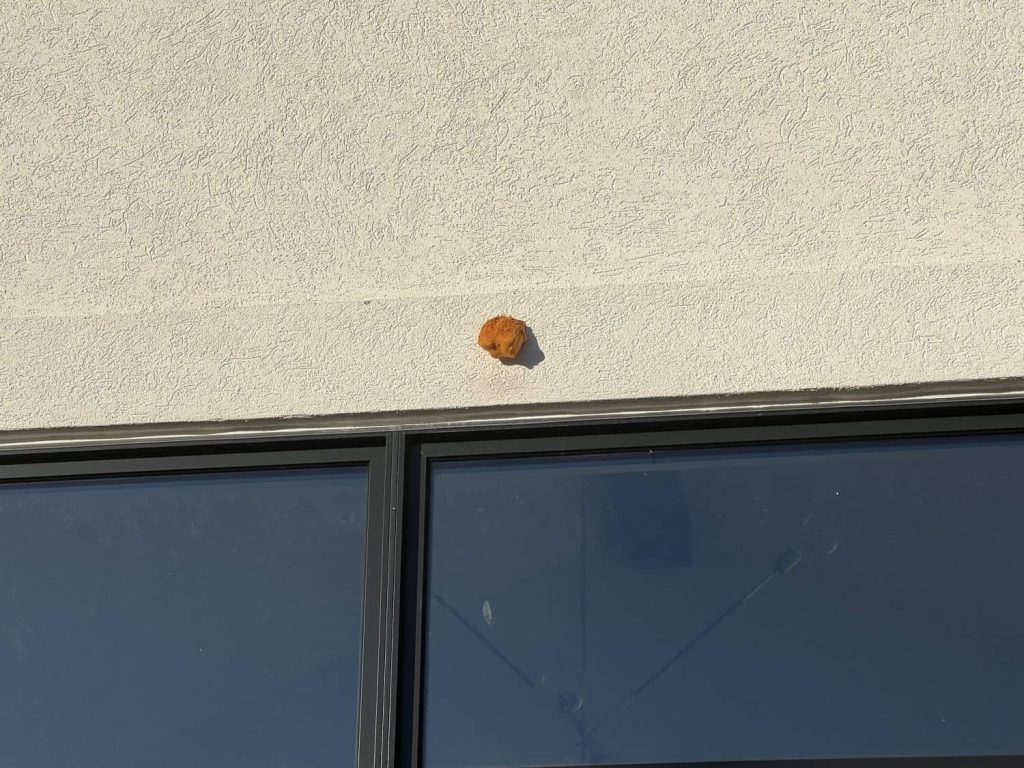
Woodpeckers stand apart from other birds in several key respects that exacerbate the damage they inflict on EIFS insulation. Their specialized traits and behaviors around food make them uniquely problematic.
Beak Types and Pecking Motivations
Not all birds share the same tools and pecking motivations as woodpeckers.
Stout, Chisel-like Beaks
Woodpeckers boast extra thick, awl-shaped beaks up to 2.5 inches long – perfect for intensive pecking. The tapered shape concentrates force onto a tiny point for maximum drilling impact.
Most songbirds, by contrast, sport thinner all-purpose beaks adept at cracking seeds or plucking berries but without the density to extensively damage building materials.
Insects as Primary Food
While many birds focus mainly on fruits, seeds or small vertebrates for sustenance, woodpeckers hone in on trees for the larvae and beetles they harbor inside. This innate tendency to furiously dig into wood translates directly to detrimental EIFS drilling.
Anchoring Adaptations
Unique physical adaptations further enable woodpeckers to unleash volleys of blows on building materials:
Zygodactyl Feet
With two toes facing forward and two backward, woodpeckers can grip or brace any which way. This grants stability for forceful overhead pecking that other birds can’t match.
Stiff Tail Feathers
Dense feathers and bones in their tails act as a sturdy prop against tree trunks or walls, offering added leverage as they drill with their heads. No songbird shares these same anchoring features.
Pain-Resistant Neck Muscles
During constant hammering, thick tendons and tissues around their necks prevent concussion damage.
Enabling Extensive Damage Over Time
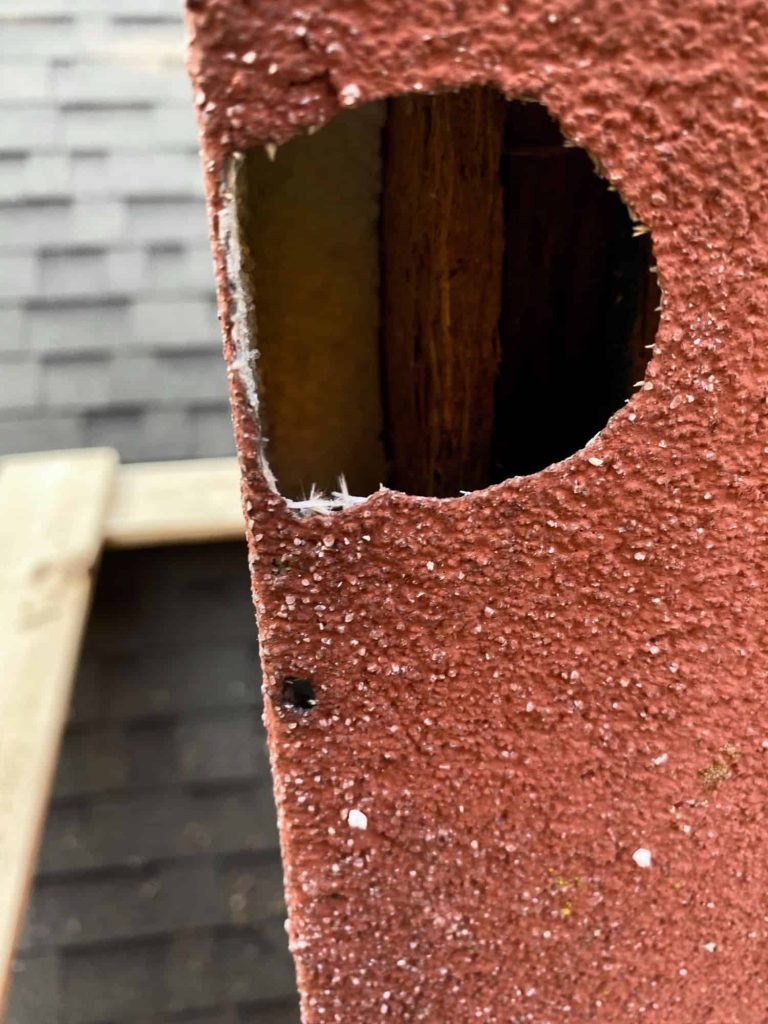
Whereas most birds peck lightly at surfaces while feeding and flutter away quickly thereafter, woodpeckers seem purpose-built to both remain riveted in place and penetrate deeply during prolonged assaults.
This makes them alone capable of inflicting major cumulative harm on EIFS. Other birds might manage a few shallow holes but lack the combination of chisel beak, anchoring feet, and cushy neck support to continue heavy blows without tiring or risking injury.
Add in the fact that 3-5 woodpeckers may take turns furiously drilling the same softened EIFS area while competing for food or nesting sites, and the peck counts multiply even faster.
Left unchecked, woodpeckers thereby produce exponentially more damage than other bird varieties. Unfortunately this capacity for greatly harming building materials lies encoded in their physical makeup. Managing them requires strategies reflecting that reality.
History and Statistics: How the Issue Has Grown Over Time
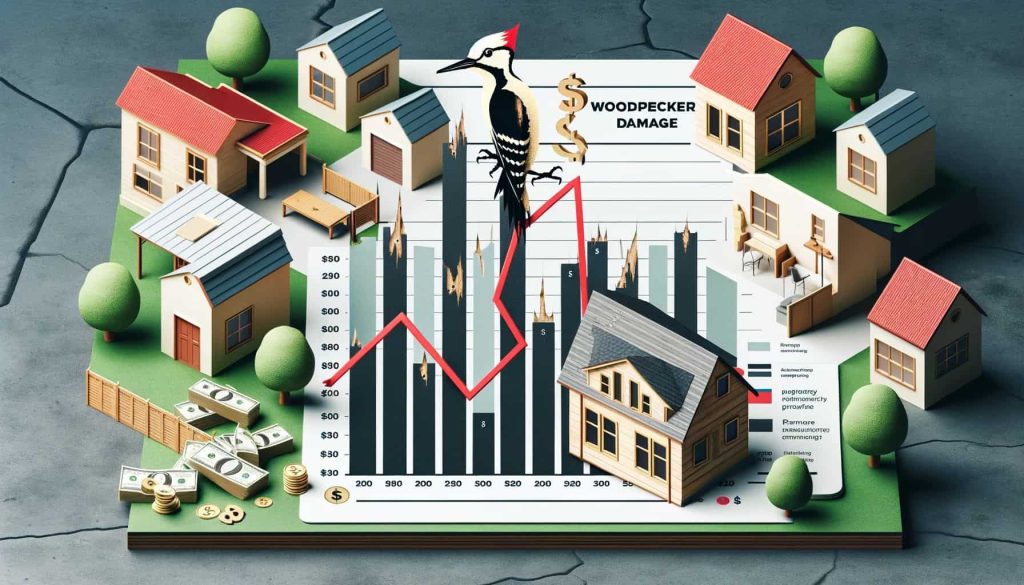
The woodpecker nuisance issue continues gaining steam on pace with increased suburbanization in wooded areas and rising installation rates for EIFS itself. Tracking developments over recent decades reveals the escalating trajectories:
Woodpecker Populations in EIFS-Dense Regions
- Southeastern U.S.
- 1980s: Approximately 1.2 million woodpeckers
- 2000s: Approximately 1.6 million (~33% increase)
- 2010 and beyond Stable at 1.5-1.6 million
- Mid-Atlantic/Northeastern U.S.
- 1980s: Approximately 400,000 woodpeckers
- 2000s: Approximately 700,000 woodpeckers (~75% increase)
- 2010 and beyond Continued increase to nearly 800,000 currently
Rise of EIFS Use in Residential and Commercial Construction
- 1980s: Less than 5% of external walls
- 2000s: 12-15% of external walls
- 2010 and beyond: 20-25% of external walls and climbing
Projected Ongoing Increases
With greater urban and suburban home development shrinking natural bird habitats plus steady growth projected for EIFS installation over traditional building exteriors, experts forecast the two trends to continue rising in parallel.
This sets the stage for further escalations in woodpecker incidents and associated repair costs without meaningful deterrence and design modifications. Just as awareness of the issue grows, so too may its negative impacts if left unaddressed.
Working Together: Opportunities for Collaboration

While woodpeckers follow their instincts drilling into welcoming EIFS surfaces, the buildings’ owners and occupants pay the price. An obvious disconnect exists between human priorities and avian behaviors.
But positive progress lies in stakeholders working together to protect both. Specifically, increased collaboration between the construction industry and wildlife conservation groups promises mutually beneficial outcomes.
Shared Incentives to Find Solutions
Contractors and property managers aim foremost to limit expensive damage and repairs. Environmental advocates desire safe habitats and food sources to maintain robust woodpecker populations.
When destruction levels escalate, the goals align around reformulating EIFS with woodpecker-deterring traits baked directly in. Developers also need cost-efficient mitigation techniques. Partnerships serve all.
Joint Research Initiatives
Combining the hands-on field expertise of contractors with the biological insights from environmental scientists provides a rich knowledge base for studies into optimal solutions.
Two initial research directions show particular promise:
- Enhanced taste/smell aversion – Trialing coatings with nausea-inducing compounds or textures rejecting birds’ tongues
- Multi-sensory deterrents – Testing integrated visual, audio and scent repellents for maximum effectiveness
Shared Outreach and Advocacy
Non-profit coalitions hold unique power to spotlight issues and lobby for legal protections. Teaming with trade organizations expands the megaphone.
Conclusion
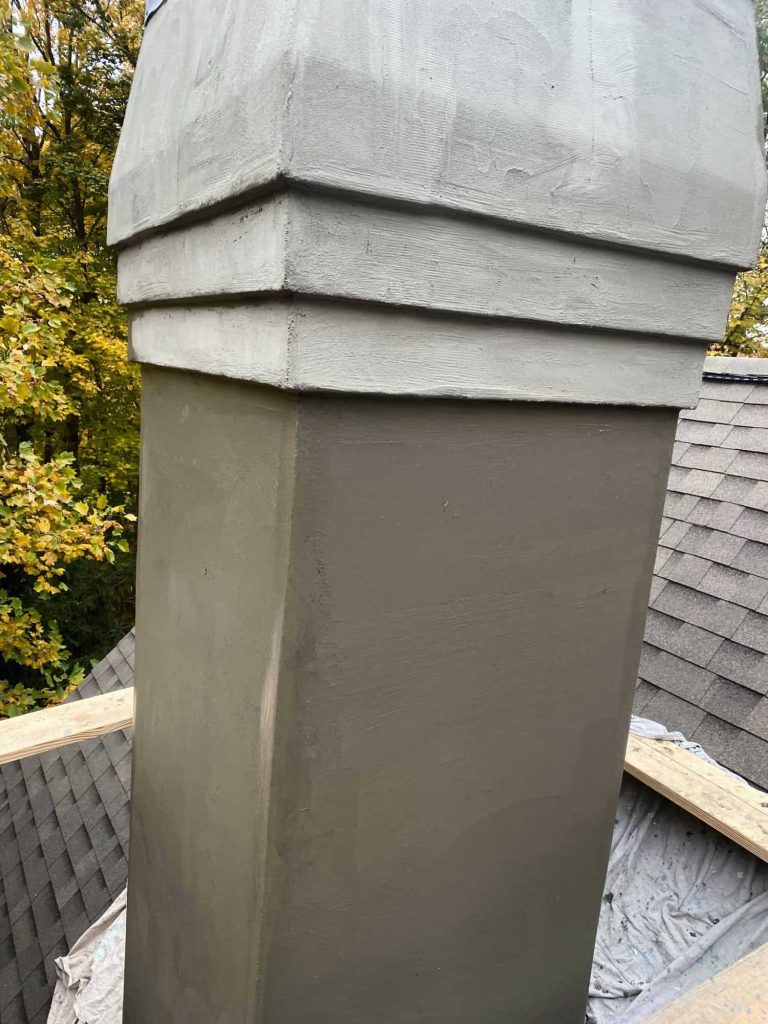
The woodpecker damage phenomenon has reached a critical juncture. As EIFS insulation increasingly dominates construction while woodpecker populations hold steady or rise across suburbs and cities, more expensive destruction looms.
Quantifiable proof shows the issue worsening and expenses skyrocketing. Collective action to deter birds while promoting coexistence represents the prudent path forward.
With stakes rising across countless properties, developers, homeowners associations, contractors and other stakeholders share responsibility for driving change. The Indiana Wall Systems team brings decades of remediation experience and commitment to lasting solutions for clients across Indiana and beyond. Contact us today to discuss woodpecker deterrence considerations for your next residential or commercial project. Our expertise offers reassurance that your EIFS investment remains protected from preventable hazards.
With woodpecker damage escalating for many property owners, the time is ripe for a focused public awareness and policy campaign. Joining forces comprises the ideal vehicle.
| Pricing can be affected by the age and type of the material originally used, as well as how high it is off the ground (accessibility) along with the wall location (within flat wall or detail) |
FAQs
What woodpecker species cause the most EIFS damage?
Downy woodpeckers, hairy woodpeckers, and northern flickers account for over two-thirds of the EIFS holes and cracks due to their size, pecking force, and nesting behaviors. The remaining one-third comes from other varieties. Understanding the key culprits helps target deterrence measures.
How frequently does EIFS damage from woodpeckers occur?
Research tracking EIFS test sites over 3-5 years reveals extremely high probabilities, with over 90% of locations suffering woodpecker damage. The number of holes per site also escalates quickly over time if left unaddressed, averaging 15-30+ strikes within the first few years.
Do other types of birds pose similar EIFS damage risks?
The unique physical adaptations of woodpeckers, especially their chisel-shaped beaks, zygodactyl feet, and cushioned neck muscles enable them alone to cause major cumulative destruction. Most songbirds lack the tools, strength or motivation for such intensive drilling.
What does it typically cost to repair woodpecker damage on EIFS?
From sealing small holes at approximately $200 each to replacing large wall sections at $15 per square foot, the costs add up quickly. Just 10-20 moderate holes over time can lead to $2,000-5,000 in repairs. For commercial buildings, far greater expenses result.
Why does woodpecker damage need to be addressed promptly?
Leaving holes or deep cracks unattended risks additional moisture penetration and structural issues long term. It also allows odors and nesting remnants to linger that further entice woodpeckers to continuing pecking those vulnerabilities. Quick fixes limit exponential destruction.

